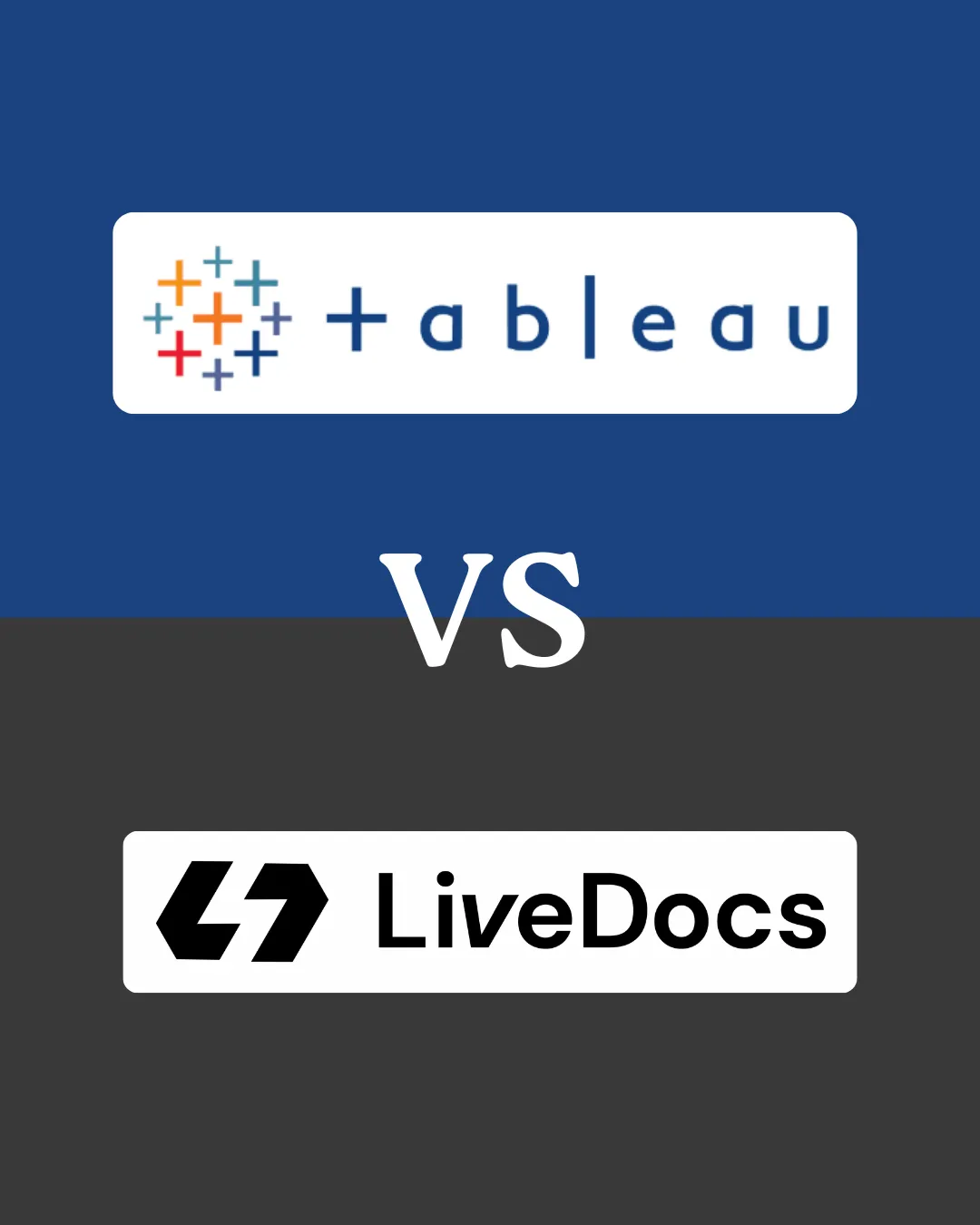Tableau vs LiveDocs: Which One?
Maybe you’re a marketing manager who needs to make sense of campaign data. Or perhaps you’re a startup founder trying to understand customer behavior without hiring a data team. Whatever brought you here, you’re probably asking the same question everyone asks: “Which tool won’t make me feel like an imposter?”
The truth? Both Livedocs and Tableau can help you work with data. But they approach the problem from completely different angles. One was built for visual storytelling with an industry, leading reputation. The other reimagined data work for the AI era, assuming you’d rather ask questions than learn software.
Let me walk you through what that actually means for someone just starting out.
What Are We Actually Comparing Here?

Tableau
Tableau has been around since 2003, which in tech years makes it practically ancient. It’s the gold standard for data visualization, the tool that democratized business intelligence by replacing complex SQL queries with drag-and-drop interfaces. When people think “data dashboards,” they’re probably picturing Tableau.
The platform excels at turning spreadsheets and databases into interactive charts, graphs, and maps. Marketing teams use it to track campaign performance. Sales leaders build revenue dashboards. Finance departments visualize budgets. It’s enterprise-grade software that millions of professionals rely on daily.
Livedocs
Livedocs is much newer, think of it as the next generation’s answer to data analysis. Instead of focusing purely on visualization, it’s built around the idea that AI should do the heavy lifting. You connect your data sources, ask questions in plain English, and the AI generates the code, runs the analysis, and presents results. All in a collaborative notebook environment. It’s less “learn our interface” and more “have a conversation with your data.”
Livedocs is the next generation’s answer to data analysis
The Setup Experience
Getting Started with Tableau
Tableau offers several versions: Desktop (the full-featured app), Public (free but your work is public), and Cloud (browser-based). For beginners, you’ll probably start with either Tableau Public or a trial of Tableau Desktop. The installation process is straightforward, download, install, launch. You’ll see a clean interface with options to connect data sources: Excel files, Google Sheets, databases, and more. Click “Connect,” navigate to your file, and boom—you’re in.
But then you’re staring at this workspace with panels labeled “Data,” “Analytics,” “Pages,” and “Marks.” There’s a “Show Me” button that suggests chart types. Columns and rows sections. Filters. It’s organized logically, but there’s a learning curve to understanding what goes where.
Think of it like getting a fancy camera. The interface makes sense once you learn it, but initially, you’re not entirely sure which buttons do what. You’ll want to watch a few tutorials before you feel confident.
Getting Started with Livedocs
Livedocs takes a different approach. You sign up online (no download needed), and within seconds you’re in a workspace that looks more like Google Docs than traditional data software.
The interface is intentionally minimal. There’s a prompt box where you can type questions or instructions. Drag a CSV file into that box? The AI immediately understands the data structure. Connect a database? Everyone on your team has access without individual setup.
Want to analyze sales data? Type: “Show me total sales by region.” The AI writes the code, runs it, and displays results. Want a chart? “Create a bar chart of top products by revenue.” Done.
The genius here is that you don’t need to know where anything is. You just ask. It’s the difference between learning Photoshop versus using Instagram filters. Both get you results, but one requires substantially less training.
The Learning Curve
Tableau’s Reality
Most experts estimate it takes between two to six months to gain solid proficiency with Tableau.
First few weeks: You’ll learn the interface, understand dimensions versus measures (Tableau’s way of organizing data), create basic bar charts and line graphs, and connect to simple data sources like Excel files.
Months 2-3: You’ll start building more complex visualizations, use calculated fields (custom formulas), work with filters and parameters, and understand how to join multiple data sources together.
Months 4-6: You’ll create full dashboards with multiple charts, implement actions (making charts interactive), add formatting and branding, and generally feel competent enough to build professional reports.
Now, here’s the catch, Tableau doesn’t require coding, which is fantastic. But it has its own logic and terminology. You need to understand how the tool thinks: when to use dimensions versus measures, how aggregation works, what a LOD (Level of Detail) calculation does. This conceptual framework takes time to internalize.
For those already familiar with Excel or basic data concepts, the learning curve shortens significantly. If you’re comfortable with pivot tables and charts, you’ll pick up Tableau faster. But if spreadsheets intimidate you, expect to be patient with yourself.
Livedocs’ Different Approach
Livedocs flips the script on what “learning” means. You can be productive within hours—not weeks—because you’re working with natural language instead of learning software patterns.
On day one, you can ask questions like:
- “What were our top-selling products last quarter?”
- “Show me revenue trends over the past year”
- “Calculate the average order value by customer segment”
The AI handles the technical implementation. You don’t need to know SQL. You don’t need to understand data modeling. You just need to know what questions matter to your business.
You’re learning how to ask effective questions, how to refine prompts when results aren’t quite right, and how to interpret what the AI generates. It’s more about critical thinking than technical mechanics.
Think about it this way: with Tableau, you’re learning to drive a manual transmission. With Livedocs, you’re learning to be a good passenger who knows how to tell the driver where to go. Both get you places, but the skills required are fundamentally different.
For Livedocs, the AI handles the technical implementation. You don’t need to know SQL. You don’t need to understand data modeling. You just need to know what questions matter to your business
Real-World Scenarios: Which Tool for What?
Let me paint some specific pictures of when each tool shines.
When Tableau Makes Sense
You’re building executive dashboards.
Your CEO wants a polished, professional, looking revenue dashboard to review every Monday. Tableau excels here. You’ll invest time creating it, but the end result looks sharp, updates automatically, and handles complex data relationships elegantly.
Your industry expects Tableau.
Many fields—finance, healthcare, consulting—standardize on Tableau. Learning it opens career doors and lets you speak the common language of business intelligence in those sectors.
You need pixel-perfect control.
Maybe you’re preparing a board presentation or a client deliverable where every detail matters. Tableau’s extensive formatting options give you that control.
You’re analyzing spatial data.
Tableau’s mapping capabilities are exceptional. If your work involves geographic analysis—retail locations, delivery routes, regional sales—Tableau handles this beautifully.
You have time to learn properly.
If you’re committed to becoming genuinely skilled at data visualization and have a few months to invest in learning, Tableau’s capabilities reward that investment.
When Livedocs Makes Sense
You need answers faster than you can learn software.
Your boss asks for an analysis by end of day. You don’t have time to watch tutorials—you need results now. Livedocs’ AI can get you there.
Your team has mixed technical skills.
Some people are comfortable with data, others definitely aren’t. Livedocs meets everyone where they are. Non-technical folks ask questions in plain English; technical teammates can still write code when needed.
You’re exploring and iterating.
Early-stage startups, product teams testing hypotheses, marketers running experiments—these scenarios involve lots of questions and rapid iteration. Livedocs’ conversational interface is built for this.
Collaboration is essential.
If your work requires constant input from multiple people—stakeholders reviewing in real time, teams brainstorming together, Livedocs’ Google Docs-style collaboration is genuinely helpful.
You want AI assistance with your actual data.
Not generic AI that helps you write formulas, but AI that understands your specific tables, columns, and relationships. Livedocs’ context-aware AI can reference your schema and suggest relevant analyses.
What Actual Users Say
I’ve talked to people using both tools. Here’s what comes up repeatedly.
Tableau users love:
The polished end results. The “wow factor” of showing executives an interactive dashboard. The depth of customization. The satisfaction of mastering a professional tool. The career opportunities it creates.
Tableau users struggle with: The learning curve (it’s real). The cost. The need for Tableau Server/Cloud to share work properly. The occasional “wait, how do I do this again?” moments when returning to something you haven’t done in a while. Performance issues with really large datasets.
Livedocs users love:
Getting answers fast. Not needing to remember syntax or procedures. The collaborative experience. AI that actually understands their data. The low barrier to entry that lets non-technical teammates contribute.
Livedocs users struggle with: It being newer means fewer resources and examples. Less control over visualization aesthetics compared to Tableau. Some uncertainty about how AI interprets prompts (you need to check its work). The need for internet connection since it’s cloud-based.
Livedocs gets your answers fast
So Which One?
Alright, let’s make this concrete. Here’s how to decide: Choose Tableau if:
- You’re pursuing a career in data analytics, business intelligence, or related fields where Tableau is standard
- You have 2-6 months to dedicate to learning properly
- You need highly polished, presentation-ready visualizations
- Your organization already uses Tableau
- You work with complex spatial data or need advanced geographic mapping
- You value having a skill that’s widely recognized and requested in job postings
- You’re comfortable investing $800+ annually in software and learning
Choose Livedocs if:
- You need to analyze data today without weeks of training
- You’re working with a team that has mixed technical abilities
- Speed and iteration matter more than pixel-perfect dashboards
- You want AI that understands your specific data, not just generic assistance
- Collaboration is central to how your team works
- You’re budget-conscious or want to try before significant investment
- You’re more interested in insights than in mastering software
The Verdict for Non-Technical Users
Here’s my straight talk: if you’re truly non-technical, have never worked seriously with data tools, and need to start being productive quickly, Livedocs is probably the better starting point.
The AI-first approach means you’re not learning software mechanics—you’re learning to ask good questions. That’s a skill that transfers regardless of what tools you eventually use. You’ll understand your data better, develop analytical thinking, and gain confidence working with information.
Tableau requires commitment. If you’re willing to invest several months learning properly, Tableau provides professional-grade capabilities and a skill that’s valuable across industries.
Final Thoughts
What I would do if I were starting today? I’d start with Livedocs’ free tier. Connect a real dataset from my work or personal life—something I’m genuinely curious about. Spend a few hours asking questions and seeing what insights emerge. Get comfortable with the idea that I can interact with data without being technical.
And honestly? That’s probably Livedocs for most non-technical users reading this. Its design philosophy—AI handling complexity, collaboration built-in, natural language interaction—removes more barriers than any drag-and-drop interface ever could.
The best, fastest agentic notebook 2026? Livedocs.
- 8x speed response
- Ask agent to find datasets for you
- Set system rules for agent
- Collaborate
- And more
Get started with Livedocs and build your first live notebook in minutes.
- 💬 If you have questions or feedback, please email directly at a[at]livedocs[dot]com
- 📣 Take Livedocs for a spin over at livedocs.com/start. Livedocs has a great free plan, with $10 per month of LLM usage on every plan
- 🤝 Say hello to the team on X and LinkedIn
Stay tuned for the next tutorial!

